Much of the military action during that first weekend of the Spanish Civil War took place at La Línea de la Concepción and both navies were active in the Straits of Gibraltar. The first news Britain had of the military uprising was via prejudiced reports from Gibraltar.
By Nick Nutter | Updated 4 May 2023 | Andalucia | History |
Login to add to YOUR Favourites or Read Later
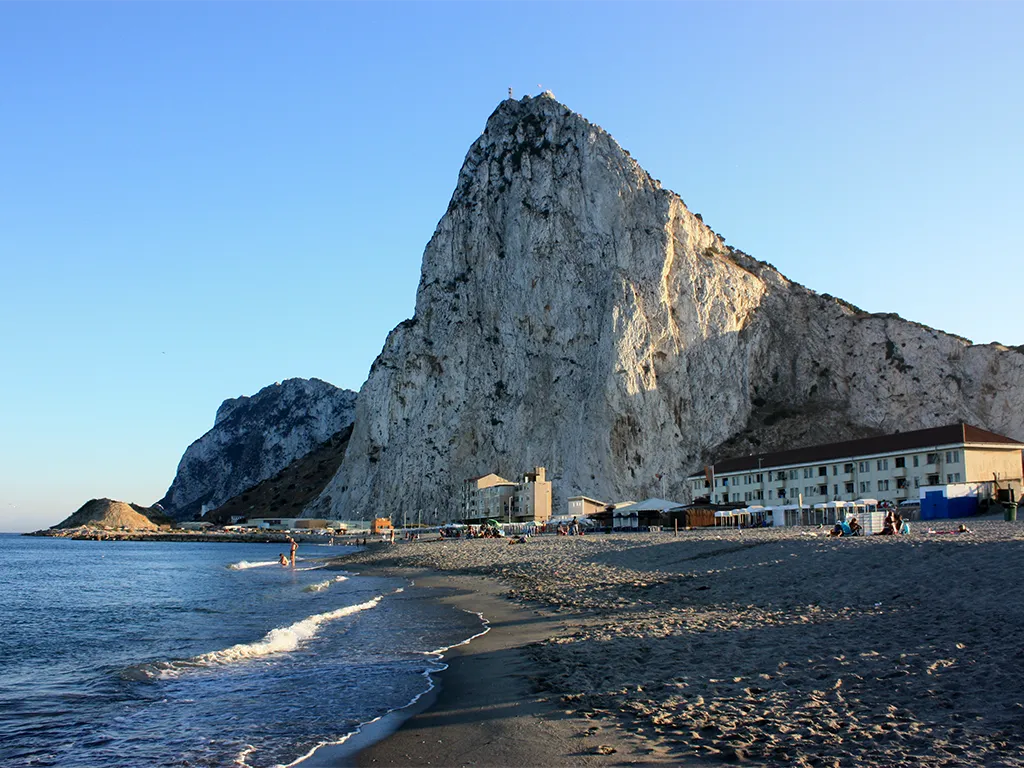
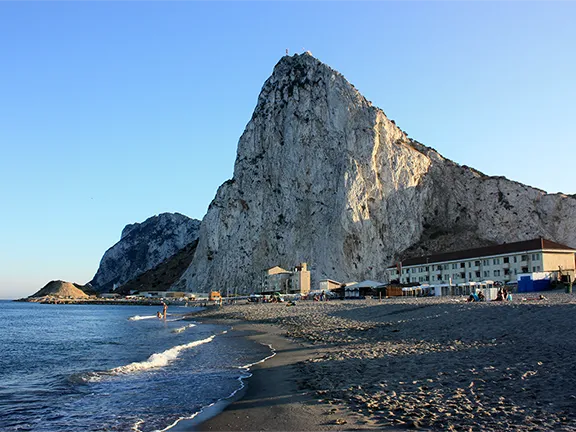
Eastern Beach Gibraltar - Sanctuary for Escaping Republicans from La Linea
The events of the first few days of the military uprising in Morocco and Spain were to colour Britain’s view of the entire war. Unfortunately, the people who should have been in post to qualify the intelligence were all on holiday. The uprising came as a total surprise. The uprising, that should have been accomplished within just a few days, did not go to plan.
What is now known as the Spanish Civil War began with an attempted coup d’etat, in other words a military rebellion, against the democratically elected Republican government of Spain. The coup was justified by the insurgents on the grounds that the elections in 1936 that resulted in a Popular Front government, had been corrupt.
In 1936, Spain was divided into eight military districts, Madrid, Seville, Valencia, Barcelona, Zaragoza, Burgos, Valladolid and La Coruña, each with one division of troops. Of the eight district commanders, only one, Miguel Cabanellas Ferrer, and his chief of staff, Federico Montaner Canet at Zaragoza conspired with the Nationalists to take over their division. The conspirators were depending on mid-level officers taking control of garrisons and either arresting the senior staff or persuading them to take part in the coup.
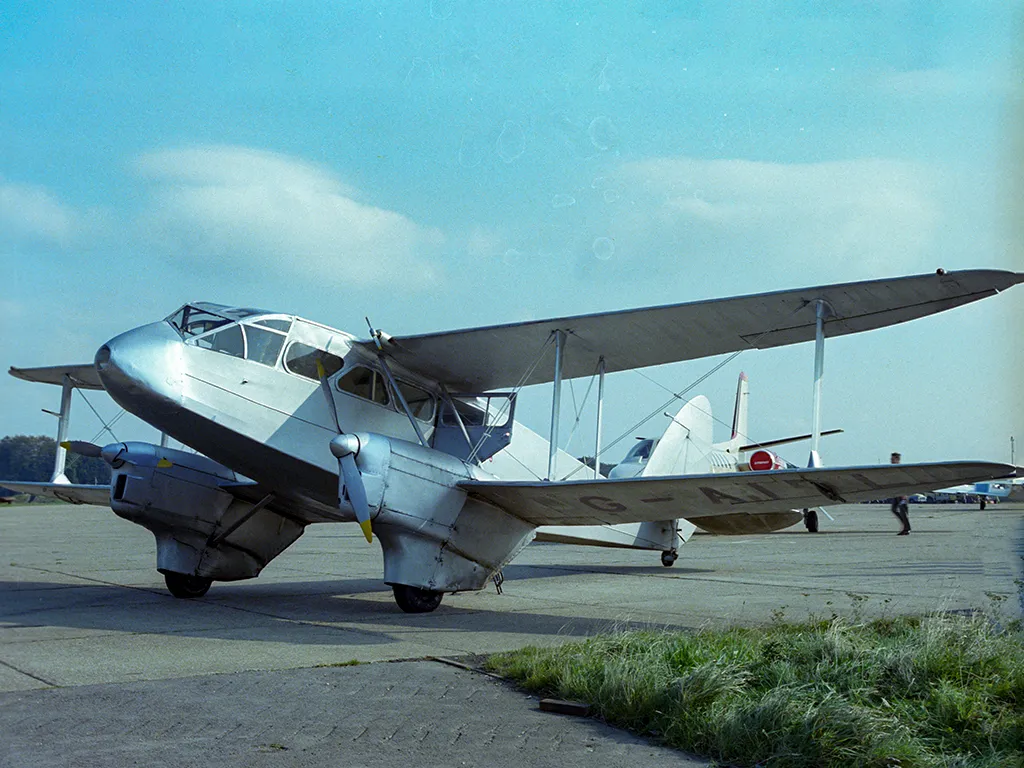
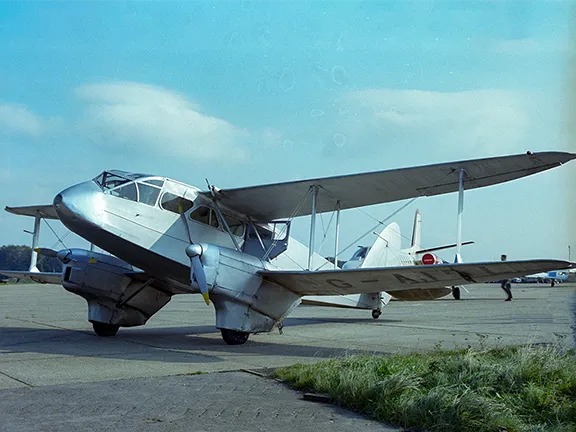
DH 89 De Havilland Dragon Rapide
The military uprising began on the 17th of July 1936, in Morocco and in garrison towns throughout Spain. The uprising was mainly planned by the three generals, Emilio Mola y Vidal, 1st Duke of Mola, Grandee of Spain, José Sanjurjo y Sacanell and Manuel Goded Llopis with General Franco a co-conspirator who was based in the Canaries.
In his first manifesto speech, broadcast from Tenerife by radio on the 18th of July, General Franco claimed he was saving Spain from anarchy and foreign subversion. A privately owned DH 89 De Havilland Dragon Rapide, flown by two British pilots, Cecil Bebb and Major Hugh Pollard, had been chartered in England on the 11 July to take Franco to Africa. Pollard was a mercenary who did odd jobs for Britain's Secret Intelligence Service. The charter, costing £2000, was paid for by Juan March. Franco flew to Spanish Morocco to take command of the Army of Africa, landing in Tetuán on Sunday 19th July 1936. On landing Franco discovered that a small contingent of soldiers from the Army of Africa had already sailed from Ceuta and landed at Cádiz and Algeciras.
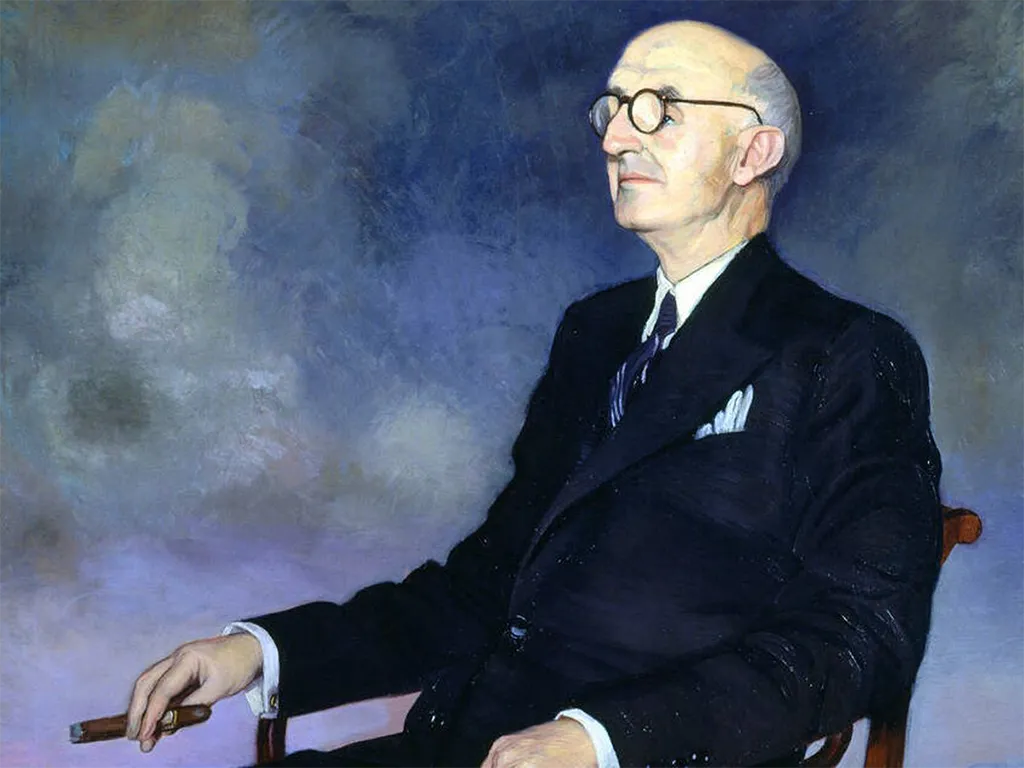
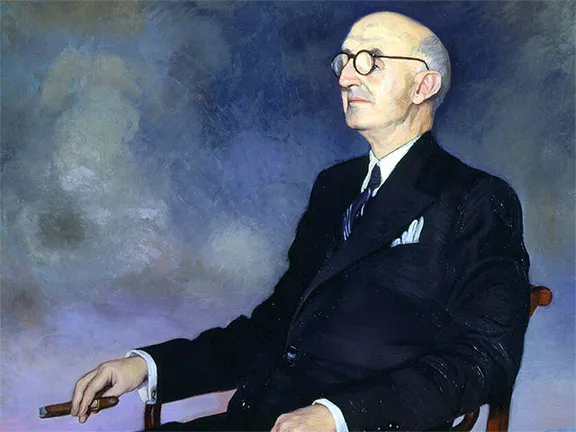
Spanish Entrepreneur Juan March
Juan March was a Spanish businessman and millionaire who played a significant role in Spanish politics during the 20th century, particularly during the Spanish Civil War. March started his career as a smuggler, running contraband goods between Spain and North Africa. He then moved into finance, founding the Banca March in 1926. The bank became one of Spain's largest and most successful, and March himself became one of the country's wealthiest individuals.
During the Spanish Civil War, March supported the Nationalist forces under General Francisco Franco, providing them with financial aid and acting as an intermediary between Franco and other conservative figures. March also smuggled weapons and supplies to the Nationalists and helped to finance their military campaigns.
In the immediate days after the military uprising, His Majesty’s Government in London was seriously hampered by a lack of representation in Spain. The ambassador, Sir Henry Chilton, was summering in San Sebastian with his corps diplomatique and the British consul, George Ogilvie-Forbes was on holiday until the middle of August.
Unsurprisingly, most of the early intelligence about the uprising available to Britain came from Gibraltar, Algeciras and the small Spanish town across the frontier, La Línea de la Concepción. Early news of a confused and confusing situation came from rumour and speculation with a few nuggets of real intelligence. The Governor of Gibraltar, General Sir Charles Harington, was on leave, in London, having taken a flat near Lord’s Cricket Ground so as not to miss any of his beloved cricket. All messages were transmitted to his club, the Naval and Military, at 94 Piccadilly. The Acting Governor who had to unravel the intelligence, was Brigadier W.T. Brooks.
The first indication that peace was about to be shattered came from the small town just across the border from Gibraltar, La Linea de la Concepción.
On Saturday 18th July 1936, just one day after the start of the uprising, La Linea was preparing to open its annual feria, the feria de julio. This week long feria was, and is, the highlight of the year for the residents of La Linea and includes fireworks displays, sideshows, fairground rides, food and football competitions, a fancy dress competition for the children, regular concerts by the Municipal band and a bullfight at the bullring on the final Sunday. The feria in 1936 did not happen.
From first thing Saturday morning, rumours started to circulate that there had been shootings and explosions near the bullring, that Falangists and Anarchists had been fighting each other and that there was fighting at the Ballesteros army barracks. A radio report picked up by residents, that the Spanish army had risen in Morocco, started speculation that the terrifying Moors and Legionnaires, troops notorious for their brutality to civilians, were crossing the Gibraltar Strait from Ceuta causing the old cry of ‘Moros en la costa’ to be heard on the streets. The cry originated when sentries on the many torres along the coast, saw the Barbary pirates approaching back in the 16th century and the cry was a warning to go home and lock the doors.
There was some substance to the radio broadcast rumour. At 2.13pm on that Saturday, the Senior Officer (Intelligence) on Gibraltar sent a signal to the Admiralty, the Commander in Chief Home Forces in London, and the C in C Mediterranean in Malta:
‘The Military Commander in Chief of Spanish Morocco announced by wireless from Ceuta at 12.00 today in essence that the Military forces, both Spanish and native, in Spanish Morocco and the Canary Islands, have revolted against the government and are in control of those areas.
Reports claim that Spanish Navy and Air Force are with them. This is supported by rumours reaching here from Tangier. Fighting reported in the vicinity of Ceuta and transport has been ordered to Algeciras to embark troops for that port today. Unconfirmed report from Cartagena states that warships there have refused to proceed to Morocco.
All quiet at present in the Gibraltar area.’
A nine-year-old girl called Mariola waited for her Gibraltarian police officer father, Gustavo Benavente, to finish his Saturday shift and take her and her brothers to the fair across the frontier. She waited in vain. Gustavo came home late that day muttering about revolución and guerra, saying there had been gunshots fired in La Linea.
Early on that Saturday morning, Philip and Mary Bower, on honeymoon from Cheshire, took the ferry from Gibraltar to Algeciras to have tea at the Reina Cristina Hotel. When they walked back to the ferry for the return trip there was a soldier reading a proclamation and troops on the jetty. The British vice consul, Mr E.G. Beckinsale, was also there and recommended that they get back to Gibraltar as quickly as possible. A uniformed Spanish army officer offered to take them by road, and they were bundled into a car stuffed with soldiers, weapons and ammunition. They were driven down the old N340 to San Roque and then onto the CA 34. As they drove into Campamento, just outside La Linea, they were halted at a barricade staffed by armed men who started shooting at them. The Spanish soldiers jumped from the car and returned fire, but Mary was hit by a bullet to her shoulder. Philip managed to get them across the road to a block of flats where they fortuitously found an apartment owned by a Spanish lady sympathetic to the Ingles. The kindly senora bandaged Mary’s shoulder and sheltered the couple until later that afternoon when the pair made their way to the frontier.
At Four Corners Gate, the gate across the frontier, Gibraltarian police officers were trying to hold back and control a stream of people, both British and Spanish residents, escaping from La Linea. The police were supported by soldiers of the 1st Battalion, Kings Own Yorkshire Light Infantry with bayonets fixed on their rifles. The gate was opened momentarily to allow a car through, and the Bowers managed to cross into Gibraltar by running behind it.
The Gibraltar Directory newspaper had a surprisingly cool version of events:
‘18th July 1936 - News received of military rising in Spain led by General Franco and other generals. General Queipo de Llano assumed power at Seville. Algeciras was taken over in a quiet manner. Disturbances in La Linea at night, fighting taking place in several streets and there were some casualties. Gibraltar residents who attended the fair passed through some anxious moments until their safe return to the Rock.’
And the following day:
‘19th July 1936 - La Línea fighting continues; several officers fled into Gibraltar this morning. By noon La Línea had been taken over. In the evening heavy firing was heard which was due to the officer commanding the Moorish regular troops being killed by a civilian. Many casualties caused when the troops retaliated. Several wounded brought to the Colonial Hospital, including the Marquez de Povar and Garcia Delgado, who was riddled with bullet holes and succumbed to his wounds. Telephone and telegraphic communication with Spain cut off. Refugees commence to arrive at Gibraltar.
and on the 20th July - 'More refugees arrive from La Linea and neighbourhood. British subjects in Marbella brought over by the British tug "Noel Birch".'
General Mola's strategy for the uprising called for the best units of the seasoned and politically reliable Army of Africa, a third of the entire army, to cross the Strait of Gibraltar from Spanish Morocco, converge rapidly on Madrid, and topple the government. The plan required a seaborne expedition, yet the conspirators made no attempt to secure naval forces to safeguard the passage. They assumed that the Spanish Navy would remain impotent and neutral, a delusion of vital consequence.
On the 18th of July, a signal was sent from the Minister of Marine in Madrid to the commanding officers of the four Spanish destroyers and a gunboat based at Ceuta and Melilla, ordering them to stop any ships bringing Franco’s troops across the Gibraltar Strait from Africa. In addition, the signal ordered them to open fire on Nationalist camps, barracks or gatherings.
At Melilla, Captain Fernando Bastarreche, a staunch supporter of Franco, tried to persuade his crew that they should not follow the orders. The crew were not responsive to his arguments but neither did they relish firing on their own compatriots. In the end the two destroyers at Melilla sailed to the Republican port of Cartagena.
At 5am on Sunday 19th July, a battalion of Moorish Regulares, under the command of Chief Commander Rodrigo Amador de los Ríos y Cabezón, embarked on the steamer ‘Cabo Espartel’ at Ceuta and set sail for Algeciras with orders to occupy the Ballesteros barracks. They disembarked at Algeciras about 9am.
The destroyer Churruca, in Nationalist hands, embarked four hundred soldiers from the Army of Africa and the cargo ship Ciudad de Algeciras (owned by Juan March) also took on soldiers and sailed for Cádiz.
Out at sea, in the Straits of Gibraltar and the Mediterranean, the Republican navy amounted to a battleship and two cruisers, nine destroyers, eight submarines and four torpedo boats, a significant threat to a Nationalist force trying to cross the Straits.
To repel the Republican navy, Franco mustered every aeroplane he could lay his hands on at Tetuán in Morocco. These consisted of Breguet biplanes and about six small training aircraft from the Seville Aero Club. From the airbase at Tetuán, these planes made repeated sorties over the Strait and, although most of their bombs missed, they managed to keep the Republican force at bay. One ship that was damaged by Nationalist bombs was the Gibel Dersa, the regular Bland Line ferry from Gibraltar to Tangier. A strong ‘note’ was despatched from the British Government via the consul in Tangier.
The military situation in the Campo de Gibraltar and the events that unfolded there, with some officers and men loyal to the legitimate Republican government and some loyal to the Nationalists, was repeated in one guise or another in many towns and cities throughout Spain. It would be many years before the full story became known, 2020 in fact, when a paper was published by José Manuel Algarbani, Presidente de la Sección 1ª, Geografía e Historia, del Instituto de Estudios Campogibraltareños in which he states, ‘The events at the Ballesteros barracks were the most violent and bloody of the entire civilian war in the region and, furthermore, they had deep repercussions among those involved and marked dynamics that would be repeated throughout the war in other parts of the country.’
On Saturday, 18th July 1936, the Campo de Gibraltar was policed and defended by the Pavía Infantry Regiment No. 7 which was deployed in Algeciras, La Línea de la Concepción and San Roque. There was also a detachment of the No. 1 Coastal Artillery Regiment distributed between Algeciras and Tarifa. The 7th Pavía Regiment was commanded by Commander Luis Chacón Lozano, loyal to the Republic. The entire civilian population of the Campo de Gibraltar was overwhelmingly Republican.
Around mid-morning, Luis Chacón Lozano, along with service officers and NCOs, heard about the military uprising in Morocco via a radio broadcast. The barracks were immediately split into two camps and Lozano ordered his NCOs to disarm those officers who favoured the Nationalist rebels. Some of those officers were taken to the frontier and pushed through Four Corners Gate just before it was closed at midnight. About 2.30pm, Lozano received a telephone call from the leader of the uprising in Algeciras, Colonel Manuel Coco, ordering Lozano to declare a state of war. Lozano asked that the order be delivered in writing. About 10pm that night, the car carrying Ensign José Sánchez Jiménez, with the order, approached La Linea. At the same barricade at Campamento from which Mary Bower had been shot, the Republican defenders opened fire. The car overturned into the ditch. Several people were injured and one police officer, Jose Luis Zubeldia Fernández, at the age of twenty-two, would become the first documented death of the war in La Línea.
Ensign Jiménez, despite being wounded, was escorted to the Ballesteros Barracks where he handed over the order. He was then treated for his wounds by the battalion’s medical captain and bedded down in the officer’s mess.
About 2am on the morning of Sunday 19th July, one of the infantry companies within the barracks that supported the military uprising, declared a state of war and shooting within the barracks started about 2.30am from premises occupied by the 2nd, 3rd, and 4th companies, all loyal to the Republic. Lozano had his loyal officers set up a machine gun on the roof. Together with other Republican officers they managed to assemble the rebelling troops in the courtyard.
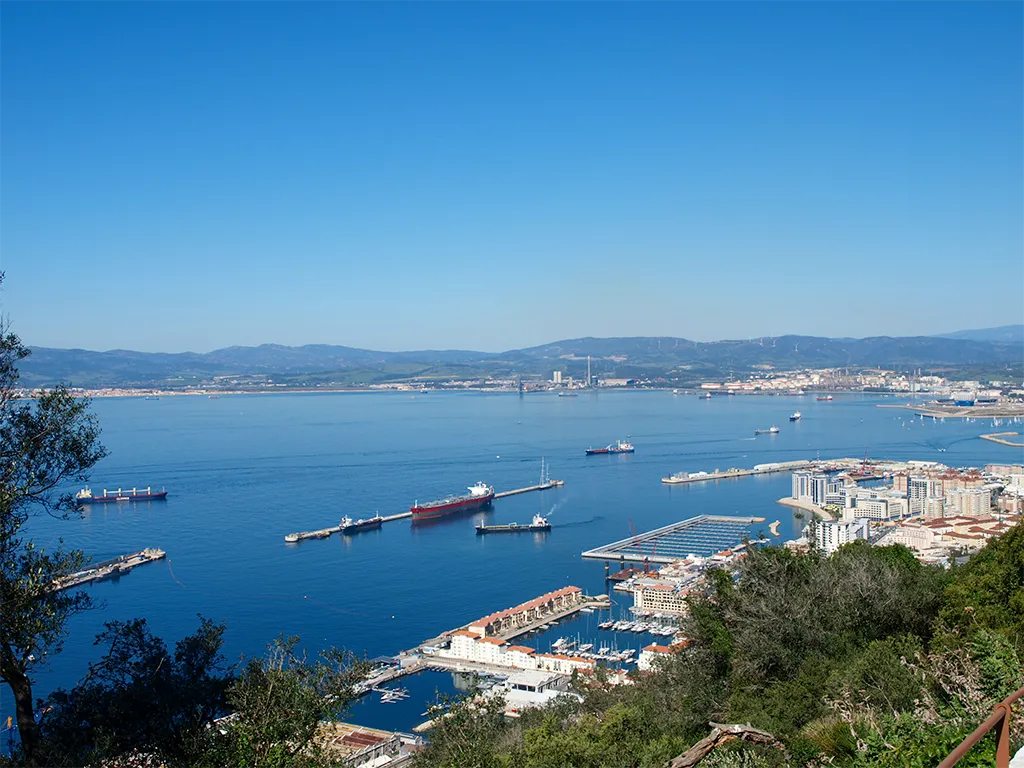
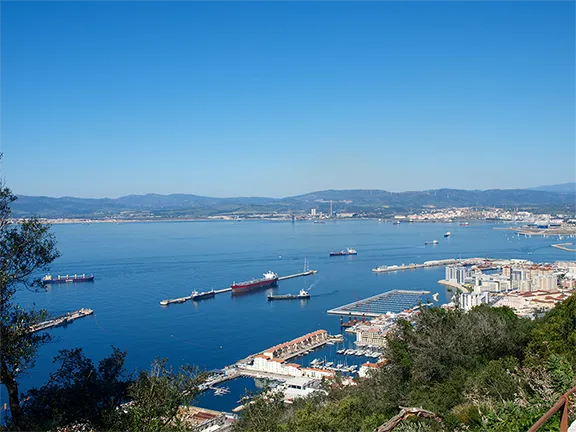
Bay of Gibraltar and naval anchorage from The Rock
About 10am on Sunday 19th July, in La Linea, several houses and businesses owned by people considered anti-Republican, were looted and the occupiers assaulted by the Republican civilian population.
At the same time, the gunboat T-19, which had gone over to the Nationalists, shelled Ballesteros barracks and it was learned that a contingent of 170 Moorish Regulares had disembarked at Algeciras and were on their way to attack the barracks. Much of the civilian population, discovering that the Moorish Regulares were on their way, assembled at the barracks gates asking for arms to defend themselves. There is some evidence that small arms, rifles, and ammunition were surreptitiously handed over. Lozano and the men remaining loyal to the Republic considered it prudent to surrender to save further bloodshed. The Moorish Regulares arrived and took possession of the barracks. The civilian crowd at the gates became vociferous and the Moorish Regulares took this as an excuse to open fire on the non-combatants. Estimates of the dead range from 90 to 150.
A mass exodus began with deserting soldiers and civilians making their way towards Gibraltar’s Eastern Beach, many swimming along the shoreline whilst others crammed into small boats. Fishing boats from La Atunera ferried refugees to Catalan Bay and crowds streamed down the road to the frontier.
All the officers and NCOs, together with police personnel who had stayed loyal to the Republic were arrested and tried by a war council. Lieutenant Antonio Herrera Corpas, Ensign Javier Martín Antoñana and Sergeants Fernando Valenzuela Cubillo, Francisco Benítez Morera, and Francisco Díaz García were executed. Eight execution orders were commuted and the remaining thirty or so defendants, including Commander Lozano, were given custodial sentences.
At mid-afternoon on Sunday 19th July, the Gibraltar Staff Officer (Intelligence) signalled London:
‘Loyal troops there [La Linea] have capitulated and both Linea and Algeciras are in the hands of revolutionaries’.
The first two days of the uprising were covered in some detail by the Spanish language Gibraltarian newspaper, ‘El Calpense’ and their headline reports give some idea of the situation just across the frontier:
- In La Línea, after two days of intense shooting, the regulars have taken control of the situation and fascist and right-wing elements collaborate with them, many of whom lived here as refugees in the Peñón.
- Those who circulate through the streets are frisked by the Moors and leaving the town is very difficult; however, many people are coming to the Rock.
- It is becoming clear that the dead and wounded reach very high numbers.
- Only workers who had to report to work were on the streets in La Línea. The military forced some of the shops to open yesterday (although the town was semi-deserted and full of pain due to the many deaths on Saturday and Sunday nights).
- A large truck with armed Moors carried the wounded and dead through the streets. The collection and transfer of the dead and wounded lasted all night, constituting a chilling spectacle.
Whilst events were unfolding in La LInea, on Sunday 19th June, six of the Republican navy ships on patrol in the Straits, the cruisers Libertad and Miguel de Cervantes, the destroyer Churruca and three gunboats sailed into Tangier in Morocco to refuel and take on water.
Tangier was a neutral international zone, governed by a Control Commission whose members were drawn from six European nations, Britain, Belgium, France, Italy, Portugal and Spain. Under normal circumstances, this would have not been a problem and Shell Oil would have welcomed the revenue. However, Franco, in Tetuán, claimed that refuelling the ships was a breach of neutrality and threatened to bomb the Republican ships at anchor in the harbour at Tangier. To avoid a diplomatic incident, the Control Commission refused at allow the Republican ships any fuel, water or provisions.
Gibralter sent a telegram to the Admiralty on the 20th of July;
‘Tangier reports that Spanish warships in harbour have placed their officers under arrest and have constituted a Soviet. They are awaiting fuel oil from Malaga and then propose to bomb Cádiz and Algeciras.’
On the 21st of July, now joined by the battleship Jaime I, the Republican ships sailed across the Strait and dropped anchor in Gibraltar Bay just outside the naval harbour.
General Franco sent a telegram to the Governor of Gibraltar claiming the ships were crewed by ‘communistic pirates and anarchists’, arguing that they should not be refuelled; a message reinforced by a telegram from Colonel Emilio March (no relation to Juan March), the Francoist Commandant of Algeciras threatening ‘consequences’ if the pirate ships were refuelled.
British naval officers visited the Libertad to speak to Commander Fernando Navarro Capdevila. They were greeted by an unshaven officer, wearing the correct uniform but, horror of horrors, no socks. It transpired that the cruiser had run out of fresh water with which to wash. Capdevila had been in Madrid when the uprising started. He had experienced a hectic and sleepless four days. He had taken an emergency flight to Cartagena where he narrowly escaped execution by rebels. He then sailed via Tangier to Gibraltar where he was finally able to remove his socks just before the arrival of the boarding party. But it left a bad impression.
Acting Governor Brooks asked the Republican fleet to move to the north side of Gibraltar Bay close to the Spanish shore. Permission to refuel and rewater was refused. The Spanish government oiler, Ophir, supplied the ships with just enough fuel to allow them to sail to Málaga.
Brooks sent the following cable to London that included the paragraph:
‘I am not satisfied that the ships mentioned belong to the Spanish government although they fly the Spanish national flag. My definite opinion is that Communists are commanding and manning them. Sailors have landed here and have given publicly in Gibraltar the Communist salute. A young officer off one of the ships says that all the officers on board are locked up.’
The maritime nations—Britain, France, Italy, Germany, and the United States—quickly dispatched naval squadrons to Spanish waters to evacuate "endangered" countrymen and to uphold their national interests, both economic and strategic.
The Royal Navy’s policy was to rescue all persons holding a British passport and other ‘respectable people’ from the chaos caused by what the orders termed ‘dangerously excited foreigners.’ Respectable was taken to mean any person with substantial means. Those orders also appertained to the soldiers and police officers stationed at the frontier between Gibraltar and La Linea.
Rear Admiral James Murray Pippon at Gibraltar sent the destroyer ‘HMS Shamrock’, to Málaga, Marbella and Seville, HMS Whitehall to Tangiers, the dockyard tug Energetic to Algeciras and the sloop HMS Cormorant to patrol off the east beach at Gibraltar.
Signals were sent out to the battlecruiser HMS Repulse to bring the 2nd Battalion Gordon Highlanders from Egypt to Gibraltar, and to six destroyers in Malta. HMS Basilisk was sent to Almeria, the other five, Boadicea, Devonshire, Keith, Keppel and Whitshed were dispatched to Alicante, Palma, Valencia and Vigo.
In the early hours of Sunday 19th July, an American journalist, Jay Allen, left his home in Torremolinos and drove to La Linea in a friend’s limousine. He was fired upon as he approached the outskirts of the town by what he later described as ‘Anarcho – Syndicalists’ and his driver was wounded. Jay managed to talk his way out of trouble, persuading the mob that, despite his luxurious mode of transport, he was a supporter of the Republican government. Jay went back to Torremolinos and said ‘Goodbye’ to his friends, Gerald Brenan and Gamel Woolsey. He packed his bags and made his way back to Estepona where he hired a fishing boat to take him, his suitcase and typewriter, to Gibraltar from where he began hunting down stories for American newspapers.
Jay Allen Cooke was a renowned American war correspondent and had moved to Spain in 1934. During the conflict, Jay Allen managed to interview Franco in Tetuán. On the 27th of July 1936, Allen published an article with the following conversation:
Allen: "How long will this go on now that the coup has failed?"
Franco: «There can be no agreement, no truce. I will save Spain from Marxism at any price».
Allen: "Does that mean that you will have to shoot half of Spain?"
Franco: «I have said at any price».
On the 3rd of October 1936, he also obtained the last interview that was conducted with José Antonio Primo de Rivera, in the Alicante jail, where he was shot.
But the article with the greatest impact signed by Allen was sent from Elvas (Portugal ), where he stayed after witnessing the Badajoz massacre, the brutal repression perpetrated by the rebel group against the population of Badajoz after the occupation of the city. The Chicago Tribune published this article entitled "Slaughter of 4,000 at Badajoz, City of Horrors" on August 30, 1936. The Chicago Tribune was considered one of the most important in the history of war journalism.
Edward FitzGerald "Gerald" Brenan, CBE, MC, was a British writer who spent much of his life in Spain. In 1930, he met the American poet and novelist Gamel Woolsey. They married in Rome in 1931. They lived in Churriana, a village near Málaga, during the early part of the Spanish Civil War, befriending the 72-year-old zoologist, Sir Peter Chalmers Mitchell. Like Sir Peter, they provided safe haven to a right-wing sympathiser, despite objecting to his political views, staying on in Spain until the city was occupied by the Nationalists.
A neighbour in Churriana was a fervent supporter of Franco called Carlos Crooke Larios. Unfortunately, he was quite vocal in his support in what was still then a Republican area patrolled by camarilla. They felt it their duty to hide Larios and his sons in their own house until they could arrange passage for them on an American warship evacuating Americans to Gibraltar.
Unwelcome in Spain due to their Republican sympathies, the couple returned to England, pitching up in Gibraltar ten days after Larios. By that time Larios was installed at the Rock Hotel with others of his ilk and openly working for Franco’s intelligence service.
Brenan was allowed to return to Spain in 1949 despite holding views which were critical of Franco's regime. Gamel Woolsey died of cancer in 1968 and is buried at the English Cemetery, Málaga. Brenan spent most of the rest of his life in Churriana near Malaga and after Woolsey's death, in Alhaurín el Grande, Málaga.
In the first few days of the military uprising, thousands of refugees arrived in Gibraltar. An encampment was set up on the Neutral Ground that could shelter about 1,200 people. The wounded were treated at the Colonial Hospital and the women and children, many semi-naked, were clothed and fed at soup kitchens set up on the racecourse at North Front. Many others took shelter with friends, in the caves that sprinkle the Rock, on hulks moored in the harbour, on the streets, in taxis and in the Alameda gardens.
The official British view was that ‘political refugees’, entitled to asylum, should be of ministerial status. In practice the vast majority were poor, working-class folk who genuinely feared they would be shot for their Republican views if they returned to Spain.
According to a Times correspondent the number of refugees was in the region of four to five thousand.
Under the heading of "Moroccan Troops at La Línea" he wrote:
Refugee British residents from La Línea are pouring into Gibraltar, which is crowded with refugees, many sleeping in parks and open spaces . . . A local shipping firm, Messrs M.H.Bland and Co has placed at the disposal of the refugees a large shed on the waterfront which is packed with women and children….
I obtained permission last night to proceed to the frontier where refugees are encamped in the Neutral Ground . . . (they) gave me details of yesterday's shooting at La Línea. They state that the Spanish troops before the arrival of the Moorish insurgents, gave their rifles and ammunition to the civilians as well as hiding some of them in the top story of the barracks.
When the Moroccans arrived, the troops pretended to be unarmed, but the Moroccans on entering the barracks were fired on from above and two were killed and many wounded. The exact number of casualties is unknown but is believed to exceed fifty.
Two British subjects, Edward Marshall and Mr. Ellicott were also wounded in the hands of [sic] stray bullets….
San Roque and La Línea are occupied by well-equipped Moroccan troops. As a result of snipping by armed civilians at La Línea last night the troops retorted with a continuous fusillade, causing many casualties especially in the district of the La Línea Infantry Barracks. A large crowd watched from the British frontier what can only be described as a miniature battle….
To alleviate the strain on the limited resources at Gibraltar, about 1,500 of the refugees were shipped to Málaga, still in Republican hands.
The majority of intelligence concerning the military uprising initially came from Gibraltar, gleaned from journalists such as Jay Allen, and SIS agents in Algeciras and La Linea de la Concepción and the ‘more respectable people’, such as Juan March and Carlos Crooke Larios. The latter sided with the Nationalists who were supposedly fighting subversion and communism. SIS agents saw scenes of chaos and the first atrocities committed by both sides and traumatised evacuees reinforced those reports. Direct contact with Republican officers, such as during the refuelling crisis, only seemed to support the view that the legitimate Republicans were a bunch of undesirable, communist, riff raff.
The Nationalist slant on events was accepted by the Gibraltar Establishment who were themselves class and caste ridden with little regard for the lower classes of 'exciteable foreigners'. Many of the respectable Spanish upper classes, such as Juan March and the Larios family, were already deeply integrated or at least welcome in the Gibraltar Establishment. Larios for instance was co Master of the Calpe Hunt, alongside the Governor’s wife. They ignored the fact that Franco and his supporters were disobeying the orders of the legitimate Republican Government.
These opinions were shared by naval officers from all the maritime nations involved. Naval officers of all these nations personally and openly favoured the rebel cause for its stated objective of establishing law and order and rooting out communism.
The official attitude in Gibraltar could be colourfully summarised by the headlines that later appeared in the Gibraltar Chronicle - ‘Malaga in the hands of the Reds’ and the Official Gazette - ‘Warships Turn Red’. This was particularly troubling to the Royal Navy who historically have always feared mutiny instigated by the lower ranks and the British Government who feared the spread of communism.
The British government's official position was that it supported a policy of non-intervention and believed that the conflict should be resolved through peaceful means, despite the fact that other European powers, such as Germany and Italy, were soon providing support to the Nationalist forces and Russia provided material to the official Republican Government in Spain.